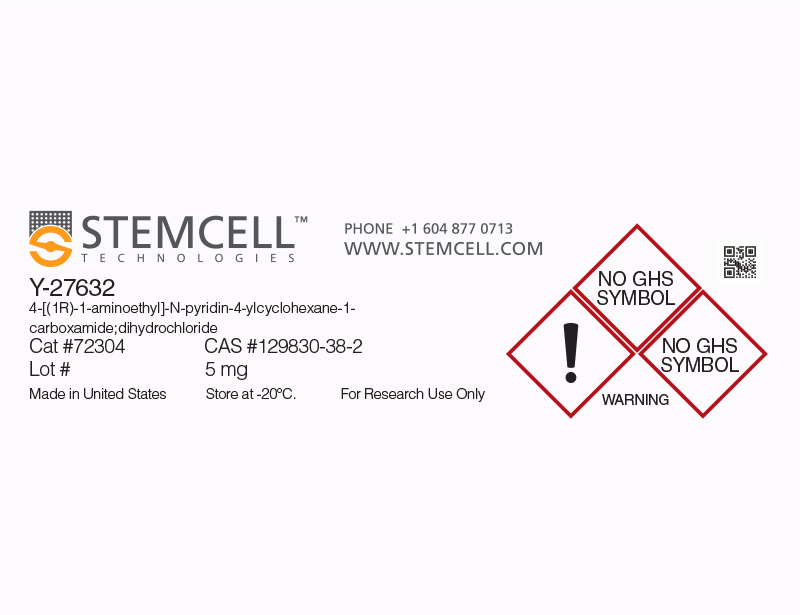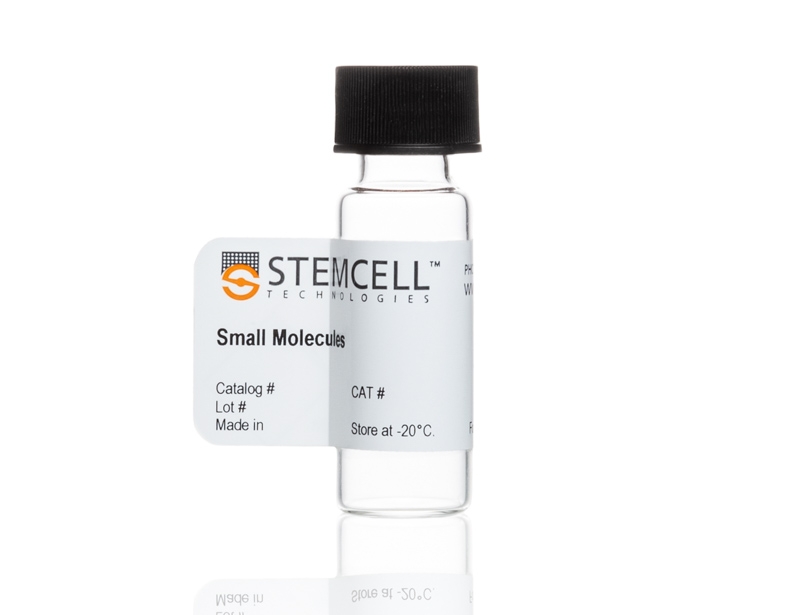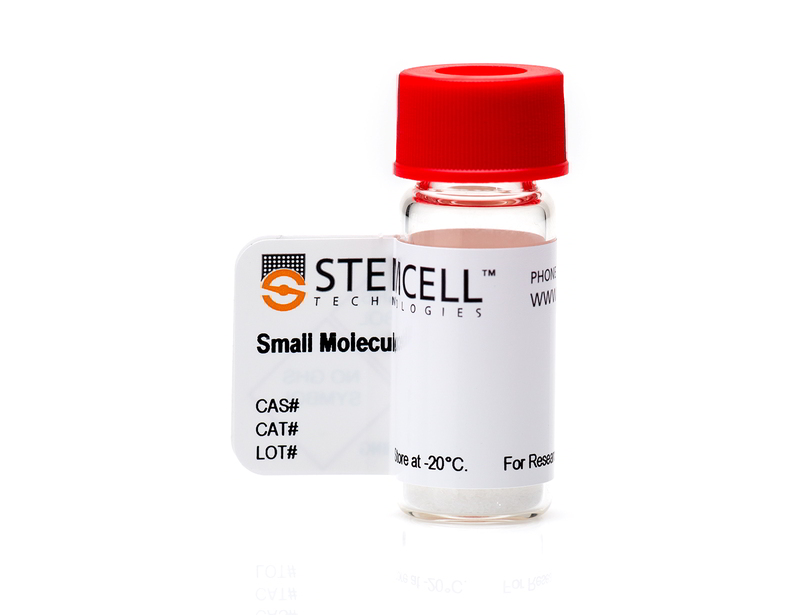概要
Y-27632 is a cell-permeable, highly potent and selective inhibitor of Rho-associated, coiled-coil containing protein kinase (ROCK). Y-27632 inhibits both ROCK1 (Ki = 220 nM) and ROCK2 (Ki = 300 nM) by competing with ATP for binding to the catalytic site (Davies et al.; Ishizaki et al.).
MAINTENANCE AND SELF-RENEWAL
· Enhances survival of human embryonic stem (ES) cells when they are dissociated to single cells by preventing dissociation-induced apoptosis (anoikis), thus increasing their cloning efficiency (Watanabe et al.).
· Improves embryoid body formation using forced-aggregation protocols (Ungrin et al.).
· Increases the survival of cryopreserved single human ES cells after thawing (Li et al.).
· Blocks apoptosis of mouse ES-derived neural precursors after dissociation and transplantation (Koyanagi et al.).
REPROGRAMMING
· Direct lineage reprogramming of fibroblasts to mature neurons, in combination with CHIR99021, RepSox, Forskolin, SP600125, Gö6983 and Valproic Acid (Hu et al.).
DIFFERENTIATION
· Improves survival of human ES cell monolayers at the initiation of differentiation protocols (Rezania et al.)
MAINTENANCE AND SELF-RENEWAL
· Enhances survival of human embryonic stem (ES) cells when they are dissociated to single cells by preventing dissociation-induced apoptosis (anoikis), thus increasing their cloning efficiency (Watanabe et al.).
· Improves embryoid body formation using forced-aggregation protocols (Ungrin et al.).
· Increases the survival of cryopreserved single human ES cells after thawing (Li et al.).
· Blocks apoptosis of mouse ES-derived neural precursors after dissociation and transplantation (Koyanagi et al.).
REPROGRAMMING
· Direct lineage reprogramming of fibroblasts to mature neurons, in combination with CHIR99021, RepSox, Forskolin, SP600125, Gö6983 and Valproic Acid (Hu et al.).
DIFFERENTIATION
· Improves survival of human ES cell monolayers at the initiation of differentiation protocols (Rezania et al.)
技术资料
| Document Type | 产品名称 | Catalog # | Lot # | 语言 |
|---|---|---|---|---|
| Product Information Sheet | Y-27632 (Dihydrochloride) | 72302, 72304, 72307, 72308 | All | English |
| Safety Data Sheet | Y-27632 (Dihydrochloride) | 72302, 72304, 72307, 72308 | All | English |
数据及文献
Publications (14)
Cell 2018 JAN
Intrinsic Immunity Shapes Viral Resistance of Stem Cells.
Abstract
Abstract
Stem cells are highly resistant to viral infection compared to their differentiated progeny; however, the mechanism is mysterious. Here, we analyzed gene expression in mammalian stem cells and cells at various stages of differentiation. We find that, conserved across species, stem cells express a subset of genes previously classified as interferon (IFN) stimulated genes (ISGs) but that expression is intrinsic, as stem cells are refractory to interferon. This intrinsic ISG expression varies in a cell-type-specific manner, and many ISGs decrease upon differentiation, at which time cells become IFN responsive, allowing induction of a broad spectrum of ISGs by IFN signaling. Importantly, we show that intrinsically expressed ISGs protect stem cells against viral infection. We demonstrate the in vivo importance of intrinsic ISG expression for protecting stem cells and their differentiation potential during viral infection. These findings have intriguing implications for understanding stem cell biology and the evolution of pathogen resistance.
STEM CELLS Translational Medicine 2016 NOV
A Novel Protocol for Directed Differentiation of C9orf72-Associated Human Induced Pluripotent Stem Cells Into Contractile Skeletal Myotubes
Abstract
Abstract
: Induced pluripotent stem cells (iPSCs) offer an unlimited resource of cells to be used for the study of underlying molecular biology of disease, therapeutic drug screening, and transplant-based regenerative medicine. However, methods for the directed differentiation of skeletal muscle for these purposes remain scarce and incomplete. Here, we present a novel, small molecule-based protocol for the generation of multinucleated skeletal myotubes using eight independent iPSC lines. Through combinatorial inhibition of phosphoinositide 3-kinase (PI3K) and glycogen synthase kinase 3β (GSK3β) with addition of bone morphogenic protein 4 (BMP4) and fibroblast growth factor 2 (FGF2), we report up to 64% conversion of iPSCs into the myogenic program by day 36 as indicated by MYOG+ cell populations. These cells began to exhibit spontaneous contractions as early as 34 days in vitro in the presence of a serum-free medium formulation. We used this protocol to obtain iPSC-derived muscle cells from frontotemporal dementia (FTD) patients harboring C9orf72 hexanucleotide repeat expansions (rGGGGCC), sporadic FTD, and unaffected controls. iPSCs derived from rGGGGCC carriers contained RNA foci but did not vary in differentiation efficiency when compared to unaffected controls nor display mislocalized TDP-43 after as many as 120 days in vitro. This study presents a rapid, efficient, and transgene-free method for generating multinucleated skeletal myotubes from iPSCs and a resource for further modeling the role of skeletal muscle in amyotrophic lateral sclerosis and other motor neuron diseases. SIGNIFICANCE Protocols to produce skeletal myotubes for disease modeling or therapy are scarce and incomplete. The present study efficiently generates functional skeletal myotubes from human induced pluripotent stem cells using a small molecule-based approach. Using this strategy, terminal myogenic induction of up to 64% in 36 days and spontaneously contractile myotubes within 34 days were achieved. Myotubes derived from patients carrying the C9orf72 repeat expansion show no change in differentiation efficiency and normal TDP-43 localization after as many as 120 days in vitro when compared to unaffected controls. This study provides an efficient, novel protocol for the generation of skeletal myotubes from human induced pluripotent stem cells that may serve as a valuable tool in drug discovery and modeling of musculoskeletal and neuromuscular diseases.
Nature protocols 2015 MAR
Efficient generation of functional CFTR-expressing airway epithelial cells from human pluripotent stem cells.
Abstract
Abstract
Airway epithelial cells are of great interest for research on lung development, regeneration and disease modeling. This protocol describes how to generate cystic fibrosis (CF) transmembrane conductance regulator protein (CFTR)-expressing airway epithelial cells from human pluripotent stem cells (PSCs). The stepwise approach from PSC culture to differentiation into progenitors and then mature epithelia with apical CFTR activity is outlined. Human PSCs that were inefficient at endoderm differentiation using our previous lung differentiation protocol were able to generate substantial lung progenitor cell populations. Augmented CFTR activity can be observed in all cultures as early as at 35 d of differentiation, and full maturation of the cells in air-liquid interface cultures occurs in textless5 weeks. This protocol can be used for drug discovery, tissue regeneration or disease modeling.
PLoS ONE 2015 MAR
Reprogramming of HUVECs into induced pluripotent stem cells (HiPSCs), generation and characterization of HiPSC-derived neurons and astrocytes
Abstract
Abstract
Neurodegenerative diseases are characterized by chronic and progressive structural or functional loss of neurons. Limitations related to the animal models of these human diseases have impeded the development of effective drugs. This emphasizes the need to establish disease models using human-derived cells. The discovery of induced pluripotent stem cell (iPSC) technology has provided novel opportunities in disease modeling, drug development, screening, and the potential for patient-matched" cellular therapies in neurodegenerative diseases. In this study�
2015 FEB
Generation of Neural Progenitor Spheres from Human Pluripotent Stem Cells in a Suspension Bioreactor
Abstract
Abstract
Conventional two-dimensional (2-D) culture systems cannot provide large numbers of human pluripotent stem cells (hPSCs) and their derivatives that are demanded for commercial and clinical applications in in vitro drug screening, disease modeling, and potentially cell therapy. The technologies that support three-dimensional (3-D) suspension culture, such as a stirred bioreactor, are generally considered as promising approaches to produce the required cells. Recently, suspension bioreactors have also been used to generate mini-brain-like structure from hPSCs for disease modeling, showing the important role of bioreactor in stem cell culture. This chapter describes a detailed culture protocol for neural commitment of hPSCs into neural progenitor cell (NPC) spheres using a spinner bioreactor. The basic steps to prepare hPSCs for bioreactor inoculation are illustrated from cell thawing to cell propagation. The method for generating NPCs from hPSCs in the spinner bioreactor along with the static control is then described. The protocol in this study can be applied to the generation of NPCs from hPSCs for further neural subtype specification, 3-D neural tissue development, or potential preclinical studies or clinical applications in neurological diseases.
Cell stem cell 2015 AUG
Direct Conversion of Normal and Alzheimer's Disease Human Fibroblasts into Neuronal Cells by Small Molecules.
Abstract
Abstract
Neuronal conversion from human fibroblasts can be induced by lineage-specific transcription factors; however, the introduction of ectopic genes limits the therapeutic applications of such induced neurons (iNs). Here, we report that human fibroblasts can be directly converted into neuronal cells by a chemical cocktail of seven small molecules, bypassing a neural progenitor stage. These human chemical-induced neuronal cells (hciNs) resembled hiPSC-derived neurons and human iNs (hiNs) with respect to morphology, gene expression profiles, and electrophysiological properties. This approach was further applied to generate hciNs from familial Alzheimer's disease patients. Taken together, our transgene-free and chemical-only approach for direct reprogramming of human fibroblasts into neurons provides an alternative strategy for modeling neurological diseases and for regenerative medicine.

 网站首页
网站首页








